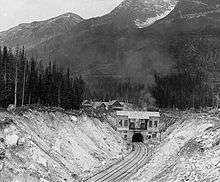Connaught Tunnel

_in_1916.jpg)
- For the Connaught tunnel in East London, England, see Eastern Counties and Thames Junction Railway
The Connaught Tunnel is a railway tunnel under the Selkirk Mountains in southeastern British Columbia, Canada, near the city of Revelstoke. The 5.022-mile (8.082 km) tunnel carries the Canadian Pacific Railway main line under Mount Macdonald and replaced the railway's previous routing over Rogers Pass, which had been struck by several deadly avalanches since its completion in 1885. At the time it was built, the Connaught Tunnel was the longest railway tunnel in North America.[1][2] It was named for the Governor General of Canada–the Prince Arthur, Duke of Connaught–who in turn was named after the province of Connaught in Ireland.
Announced in February 1913, the contract was awarded on July 1, 1913, to Foley Bros. Welch and Stewart. The tunnel was designed by John G. Sullivan who joined the Canadian Pacific Railway in 1900 and eventually became Chief Engineer for Canada.[3] A small tunnel was built, from which cross cuts were made to the main tunnel so work could carry on at a number of headings. The sub-contractor guaranteed to drill 900 feet (270 m) of tunnel per month and started on April 2, 1914. Compressed air equipment and narrow gauge locomotives were used inside the tunnel. The company town housed some 300 workers. The tunnel was completed before the original deadline, with operation beginning December 16, 1916. It had a grade of only 0.95 per cent westward, and was tangent; light at one end can be seen at the other, more than five miles away.
It cost $5.5 million, while a further $3 million were spent on track revision, which saw 14.5 miles (23.3 km) abandoned including the Loops and over 4 miles (6.4 km) of snow sheds. In all, the route was shortened by 4.3 miles (6.9 km).
Problems were encountered with ventilation, loose rocks and wet rails, which caused trains to stall. The tunnel was later lined with reinforced concrete and equipped with a better ventilation system. Originally double tracked, it was realigned with a single track in 1959 to accommodate higher freight cars.
In the late 1980s, the Mount Macdonald Tunnel was built to supplement the Connaught Tunnel and to lessen the grade on the eastern approach to the pass. Trains now predominantly travel east through the Connaught Tunnel and west through the Mount Macdonald Tunnel.
In 2001, the Connaught Tunnel was inducted into the North America Railway Hall of Fame.[4] The Hall of Fame recognizes and establishes an enduring tribute to the people and things that have made significant contribution relating to railway industry in North America. The Connaught Tunnel was inducted in the "Facilities and Structures" category with "National" significance.
See also
- The Kicking Horse Pass Spiral Tunnels (which in 1909 eliminated the dangerous Big Hill), Field Hill, Rogers Pass and the Mount Macdonald Tunnel and its associated grade reductions are other significant features in the mountain history of the CPR.
- The 1910 Rogers Pass avalanche, the deadliest avalanche in Canadian history, in which 58 workers of the CPR were killed. Once this avalanche happened, over 200 people had died from avalanches on the pass. This one was the final straw which ultimately led CP to construct the Connaught Tunnel.
References
- Booth, Jan (1985). Canadian Pacific in the Rockies: 100 Years in Rogers Pass. BRMNA, Calgary, Alberta. ISBN 0-919487-15-7.
- ↑ "Rogers Pass a History of the Canadian Pacific Railway and Trans-Canada Highway crossing.". cdnrail.railfan.net. Retrieved 2016-05-09.
- ↑ "Canadian Railway Hall of Fame -". www.railfame.ca. Retrieved 2016-05-09.
- ↑ http://www.mhs.mb.ca/docs/people/sullivan_jg.shtml
- ↑ North America Railway Hall of Fame
Coordinates: 51°18′05″N 117°28′35″W / 51.30139°N 117.47639°W